How to Make a Photo Mosaic - TurboMosaic Help
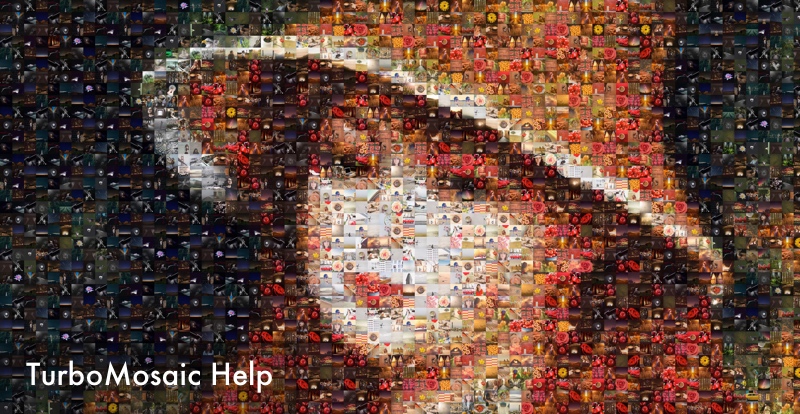
Making a photo mosaic from your pictures using TurboMosaic is super simple; anyone with or without design experience can do it.
In this documentation, you will learn to make a photo mosaic using TurboMosaic software for Mac or Windows PC.
We highly recommend that you start by viewing the Quick Start Video and then move on to check other options.
Quick Start
The following sections provide a highly recommended quick start video and suggestions for selecting the main picture and tile pictures that result in a superb mosaic.
Quick Start Video (Must Watch)
This video gives a brief overview of creating a photo mosaic in TurboMosaic. The video uses Mac OS X software for the demo. Still, it can be used by Windows users because the Windows PC software has a similar user interface and functionality.
Recommendations for Main Picture
An image with intricate patterns, tiny text, many people, or little contrast doesn't work well as the main picture. On the other hand, a face closeup, simple logos, photos of large objects, and pictures with a lot of colour variation work quite well.
Examples of bad main pictures

A picture with multiple people and tiny faces.

An image with low colour contrast.
Examples of suitable main pictures
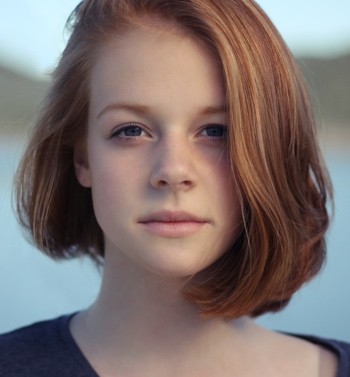
Close-up of a face.

A Large bird with good colour contrast.
Recommendations for Tile Pictures
Many tile pictures with a broad range of colours work well because this allows better cell mapping with the main image.
Photo Mosaic Settings
The following sections detail various settings used to design and customise your photo mosaic.
Cell Style
You can select a Rectangular, Hexagonal, Circular, or Diamond cell for your mosaic. Here's a sample close-up photo of mosaics made using these cells.
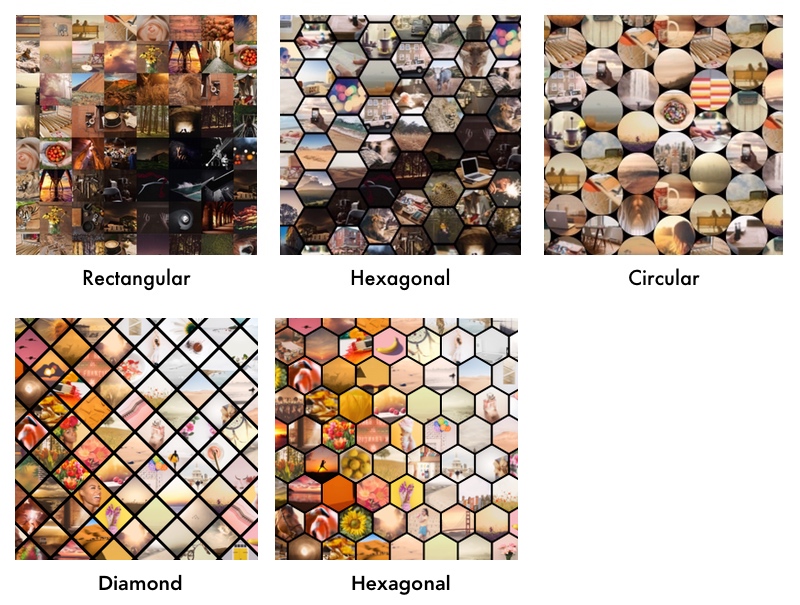
Number of Tiles/Cells
You might like to go for many smaller cells or a small number of bigger cells. You can increase/decrease the number of cells in your mosaic as per your requirement.
In mosaics with Rectangular cells, you can increase/reduce the number of rows and columns. If you're using Hexagonal, Circular, or Diamond shaped cells, you can increase or decrease the number of cells in your mosaic.
Cell Size When Using Rectangular Cells
Rectangular tile cells can have the following an aspect ratios:
- 1 : 1 (Square)
- 4 : 3
- 3 : 4
- 3 : 2
- 2 : 3
- 16 : 9
- 9 : 16
- 2 : 1
- 1 : 2
Here’s a sample photo mosaic with 3 : 2 cells:
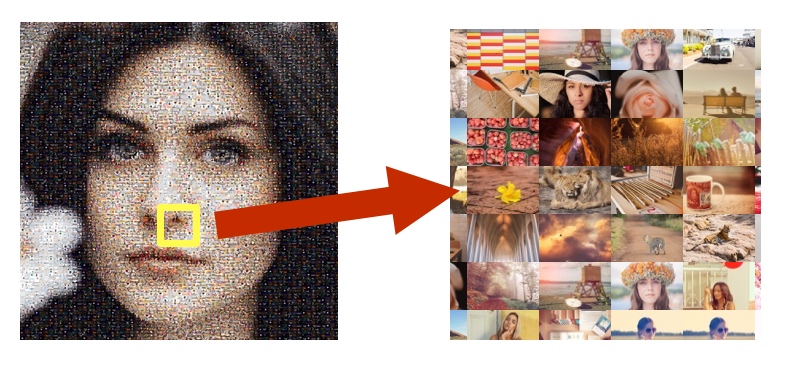
Pictures that have a different aspect ratio are automatically centre cropped. For example, the following sample photo shows how an image will be automatically cropped for a 1 : 1 cell.
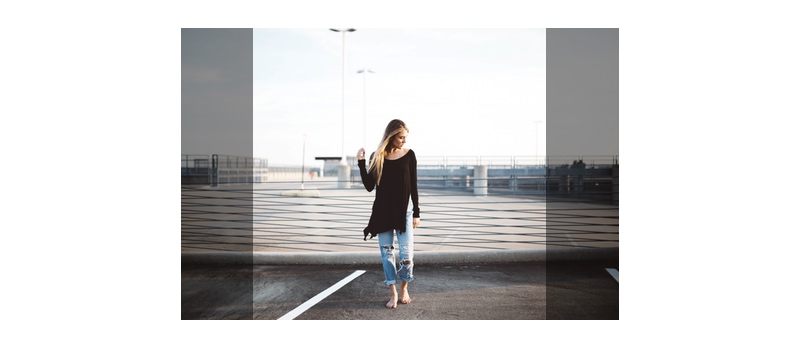
Tile Spacing & Background
Usually, you’d make a mosaic with no spacing between tiles.
But, you can spice up your mosaic by adding a little spacing with a background colour or the main picture to show through this space.
Here’s a sample mosaic using Hexagonal tiles and black background colour showing through the space between tiles:
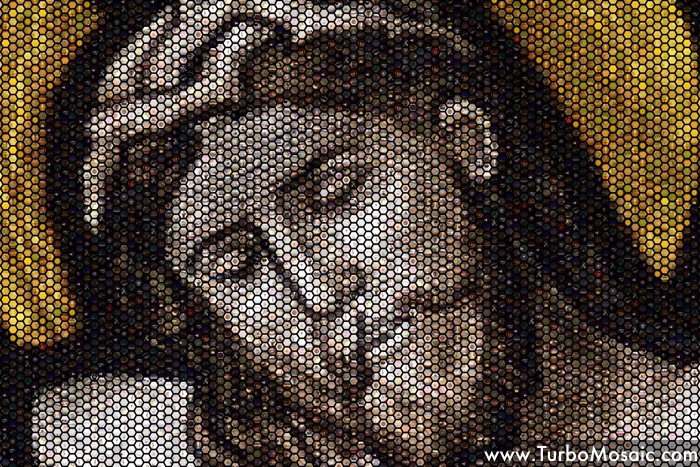
Cell Colorization
We try hard to map the source image with the tile pictures. Still, our vast experience shows that sometimes it isn't possible to do this well. Such as when the tile pictures don't have enough colour variety for proper cell mapping.
For example, if your tile pictures are all dark in colour. Whereas the main image has predominantly light shades, it would be impossible to map the main picture using those tile pictures. We recommend using cell colorization to better match cell colours in such scenarios.
Here's an example of the same photo mosaic — the one on the left doesn't use colorization. In contrast, the one on the right uses colorization.
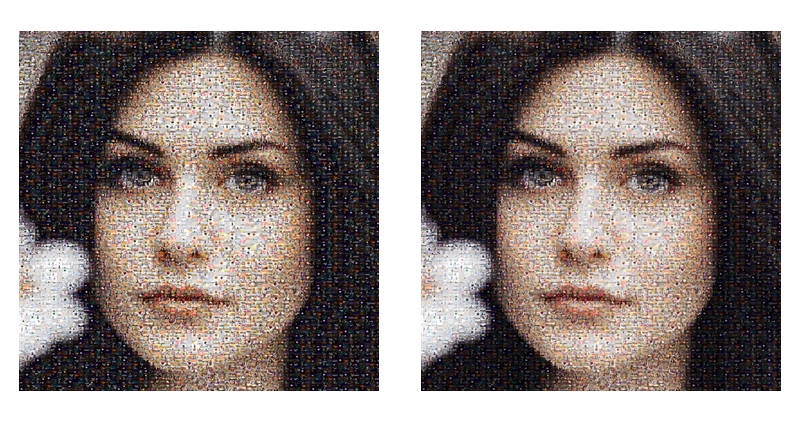
Main Photo Overlay
Using Main Photo Overlay superimposes the original main picture on the output.
We don't recommend using this option because the use of this option results in an "untrue/false" mosaic.
This method is employed by low-quality software/mosaic services that cannot accurately map the tile pictures with the main image.
Use each tile picture at least once
(available in version 3.0.0 and newer software)
Let's say that you're making a photo mosaic using headshots of students in a school. You'd want to make sure that each tile picture you've added gets used at least once in the mosaic.
"Use Each Tile Picture At least Once" setting ensures that each tile picture is used at least once in your mosaic. Some of the tile pictures might not match well, but they will still be used if you select this setting; this can result in a less than optimal mosaic.
If you uncheck this setting, the mosaic algorithm will choose the best matching picture for each cell. Some tile pictures that don't match well with any cell might not get used in your mosaic.
You might like to compare your mosaic with this setting on and off.
Cell Mirroring
Cell mirroring allows the tile picture to be flipped horizontally. This option can result in better cell mapping because it gives the cell mapping algorithm more picture options.
For example, given the tile picture on the left, cell mirroring will allow the use of both the pictures in the photo mosaic.

You should not use mirroring when your tile pictures contain text. The text in the mirrored image will turn illegible, as shown in the sample pictures below.

Duplicate Spacing
Duplicate spacing is the minimum number of cells between two cells using the same picture. Cells that use mirrored images are also considered duplicates.
The first example below shows cells with a duplicate spacing of 0. The second example shows cells with a duplicate spacing of 3.
The following figure shows the duplicate spacing of various cells from the blue cell in a hexagonal cell layout:
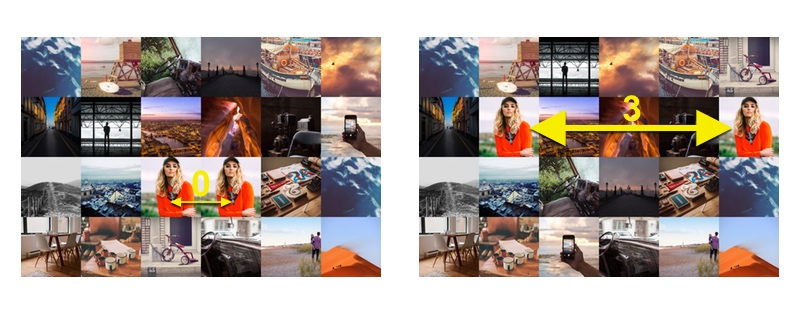
The following figure shows the duplicate spacing of various cells from the blue cell in a hexagonal cell layout:
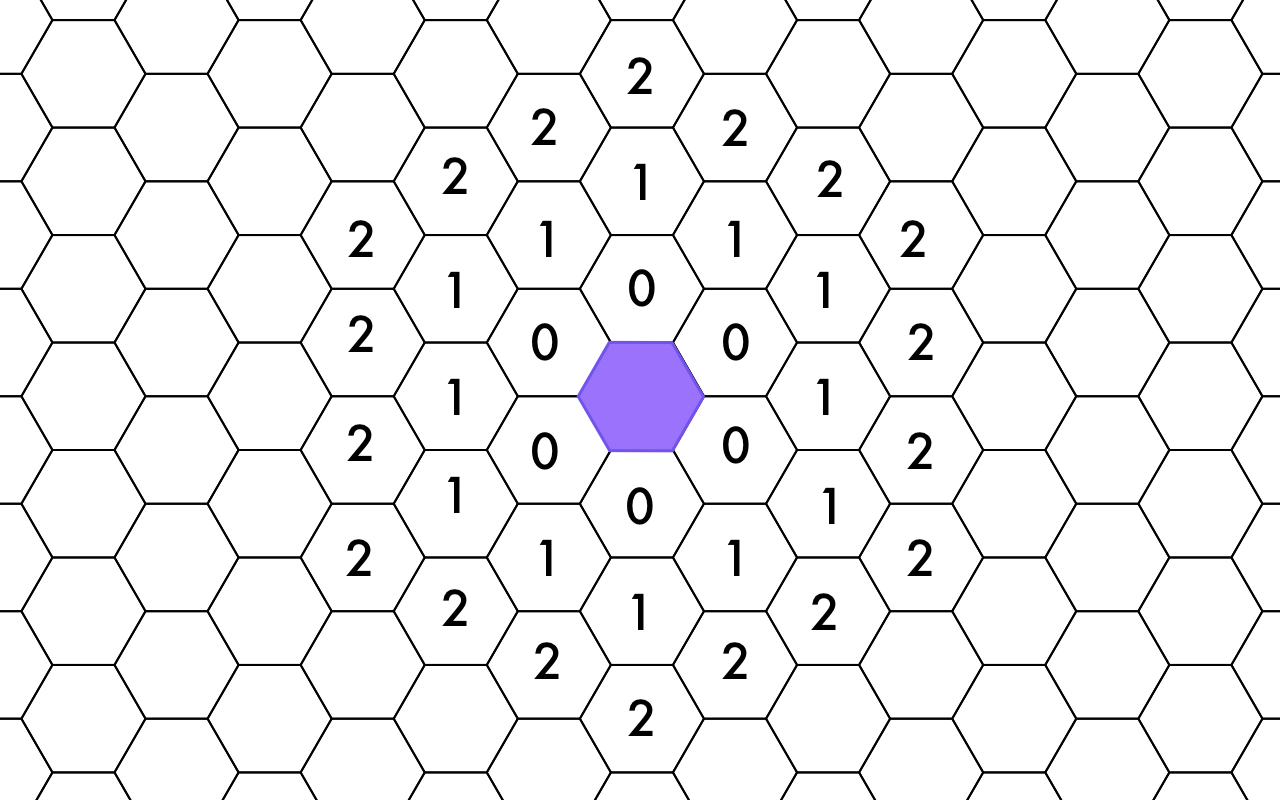
How To’s
The following sections answer the common questions that arise while using TurboMosaic.
How to crop/adjust a picture in its cell
Starting from version 3.6.2 and newer, TurboMosaic allows you to crop a picture in its cell. Follow these steps:
- Click the cell to select the picture.
- Use the crop button.
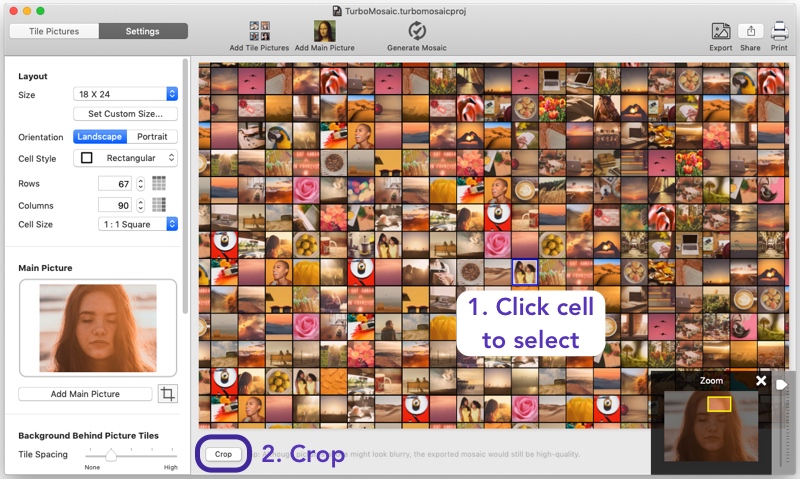
How to put a specific image in a photo mosaic cell
Starting from version 3.6.4 and newer, TurboMosaic allows you to drag a picture into a cell, as shown below. Follow these steps:
- Zoom into the mosaic so that the cell is clearly visible.
- Find the picture in the list of tile pictures.
- Drag the picture to the cell.
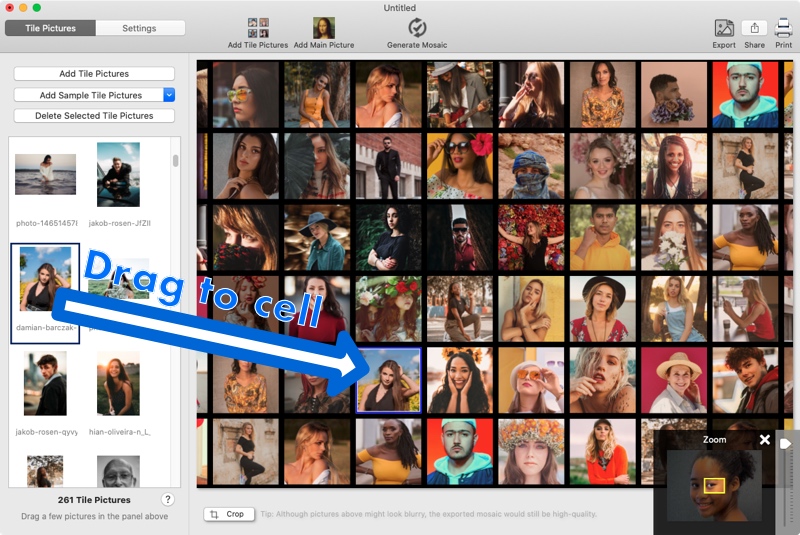
How to use each image only once in your mosaic?
Often, you'd want to make a mosaic with no repetition of pictures — where each image is used only once. In such a case, you'd need at least as many tile pictures as the number of cells in your mosaic. For example, in a mosaic with 25 rows and 30 columns, you'd need 25 X 30 = 750 pictures.
You can control the repetition of pictures by changing the duplicate spacing. Increase duplicate spacing to reduce the duplication of images.
If you want no repetition at all, use a very high value for duplicate spacing. For example, in a mosaic with 25 rows and 30 columns, use a duplicate spacing of 31. This will ensure that no picture appears more than once.
The mosaic algorithm tries to best match a picture with a cell. Reducing repetition reduces the number of photo choices available for each cell, resulting in a lower quality mosaic.
We recommend two things for a higher quality mosaic:
- Add a large number of tile pictures,
- Instead of forcing zero repetition by using a very high value for duplicate spacing, allow low picture repetition by using a higher value of duplicate spacing. For example, a duplicate spacing of 5 or 6 would work well in a mosaic of 25 rows and 30 columns.
How to use a customized size for your photo mosaic?
TurboMosaic comes with many default mosaic sizes that you can choose from for your mosaic. But, you might not find the required size among the list of default sizes. In such a scenario, you can use a customized size by selecting “Set Custom Size” from the Size drop-down, as shown in the screenshot below:
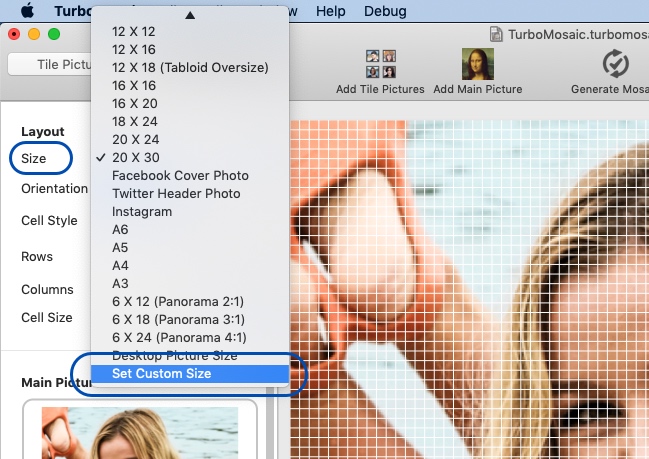
How to print the created photo mosaic?
To print the created photo mosaic, First, export it as a JPG image. Second, print the JPG image using a local printer or at an online/in-store printing service - such as at Walgreens, Costco, Staples, Snapfish, Walmart, FedEx etc.
How to export the generated photo mosaic picture arrangement as a comma-separated value (.csv) file?
(Available in v3.0.22 and newer, for Professional-Plus edition only. Only applicable to Rectangular cell photo mosaics.)
If you're using the Professional-Plus edition and v3.0.22 or newer, you can export the generated mosaic arrangement as a comma-separated value (.csv) file for Rectangular cell photo mosaics. Open File > Export Picture Arrangement... menu to export the layout.